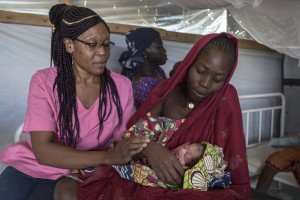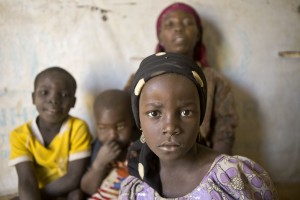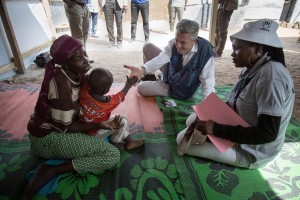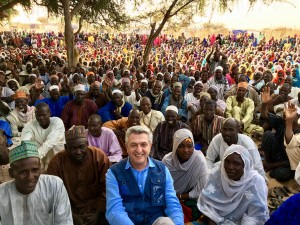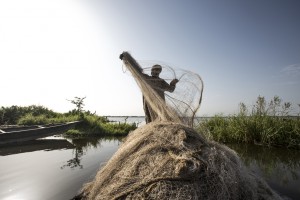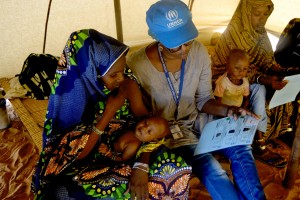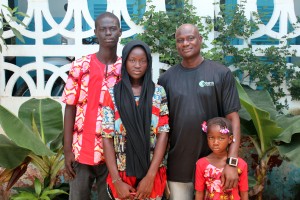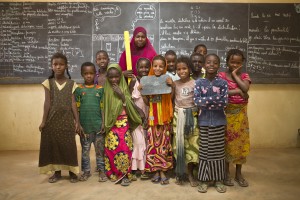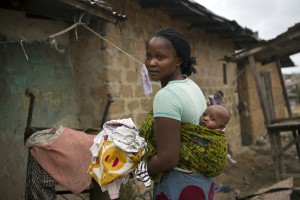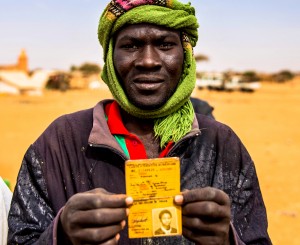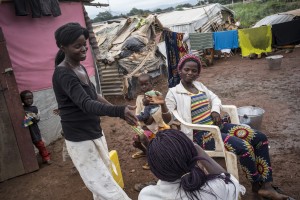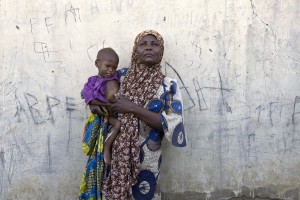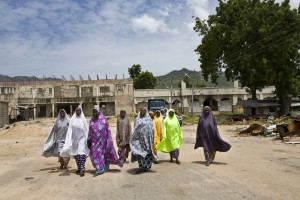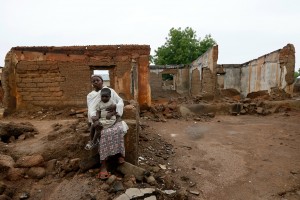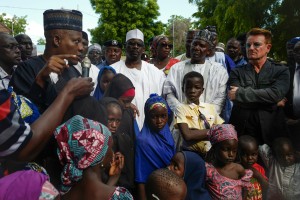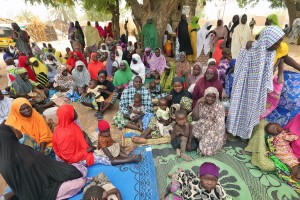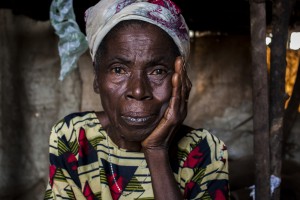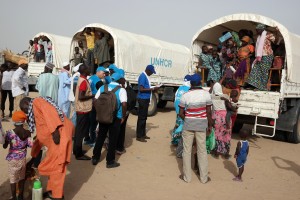On the way to resettlement
Fears and Hopes of a Central African Refugee
LOMÉ, TOGO, 2 March 2016 (UNHCR) – In Lomé, Togo, where she found refuge with her four-year old son since 2014, Lyna*, a 26-year-old refugee from the Central African Republic, is struggling to hide her excitement. Her case was submitted by the United Nations High Commissioner for Refugees (UNHCR) for resettlement to a third country and she has just learned that it was approved. Lyna and her son’s next destination in a few months is Canada.
“Resettlement is one of the solutions that UNHCR can provide to refugees who face specific protection issues,” says Lucie Gagné, Senior Resettlement Officer to the regional office of the agency in Dakar. “Resettlement involves the identification and transfer of refugees from a State in which they have sought protection to another State willing to accept them as refugees and then grant them permanent resident status.” This status grants the refugees a better chance to start a new life and/or receive support for their particular vulnerability.
Lyna, who lives in Togo without any family or husband, has been identified by UNHCR as a survivor of violence and torture as well as a woman at risk in a situation of asylum. This situation of extreme vulnerability led the organization to present her case for resettlement in a third country.
“It’s a new beginning for my child and myself”
It is therefore an important event in Lyna’s life. “It’s a new beginning for my child and myself and I thank God.” Lyna looks intensely at her son, then her head in her hands, sheds a couple of tears furtively. “I am a victim of the war in my country,” she explains. After a long silence, her face darkens, and Lyna cries again. Painful memories of the war in her country and the stigma she suffers today are still vivid in spirit and flesh. She can’t help recalling memories of that nightmarish night when everything changed around her.
“I was a third-year medical student at the University of Bangui. I lived with my fiancé in Miskine, a predominantly Muslim neighborhood of the capital. On the night of 6 December 2013, soldiers from the Seleka** entered our house by breaking the door. They beat my fiancé and made him lie down on the ground. Then, three of them raped me one after another in front of him.”
After the rape, Lyna attempted to put an end to her life by swallowing drugs. “I could not take it anymore. I was going insane. I was not feeling well and I tried to commit suicide to end this life.” Adding to the trauma of rape is the stigma from her immediate environment, family and friends, some of whom have ended up rejecting the young woman.
Fearing to see her perpetrators again, the young woman decided to take the path of exile. “I had nightmares in which I saw my attackers again, I was afraid they would come back, I could not stand to stay in Bangui and I decided to leave the country.”
With the support of her fiancé, she managed to leave the capital to go to Douala, Cameroon, where she took refuge for five weeks with a friend before going to Togo to join her son. The boy had been brought for safety concerns a few weeks earlier by the family of her fiancé. Since then, the fiancé, also traumatized by the events they experienced, ended his relationship with Lyna. “UNHCR helped me a lot. I received full medical support. I have received psycho-social support that allowed me to recover mentally and emotionally.”
In Lomé, where she lives while waiting to fly to Canada, Lyna does small trade between the capital of Togo and Cotonou, Benin’s capital, in an attempt to meet her needs and those of her son. “I live alone with him. I go buy clothes and jewelry in Cotonou that I resell here in Lome, but this activity is very exhausting and I hardly manage to make ends meet.”
“I do not know what to expect there! I am both happy and anxious”
The joy of soon continuing to live her life in Canada, a country she only knows by name, is not without apprehension. “I do not know what to expect there! I am both happy and anxious,” she says. “How will my son and I live? Will I be able to continue my medical studies? Will I manage to adjust, especially since I do not know anyone? These are questions that remain unanswered for the time being.”
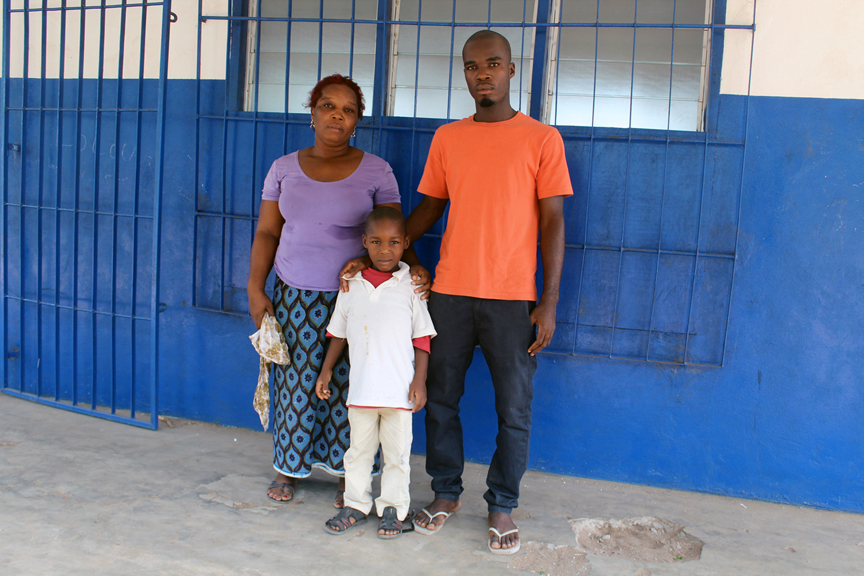
Cyriane, a forty-year-old Ivorian refugee widow, poses here with her two sons Boris, 5 and Bendel, 24, in Avepozo refugee camp in Lomé, Togo. They have just been accepted into the United States resettlement programme. Cyriane lost her husband during the post election crisis in Côte d’Ivoire in 2011, and fled her country with her children to escape further violence. She is looking forward to starting a new life in the US with her sons. UNHCR / Simplice Kpandji
Like Lyna, about 536 refugees were identified and their cases submitted for the resettlement program in West Africa in 2015 with an acceptance rate of 98%. “The number of submissions is very low compared to the resettlement needs of 7.635 refugees estimated by UNHCR in 2015 for the region,***” says Lucie Gagné. “We hope the resettlement countries**** will continue to maintain their interest in the refugees from this region despite the heavy demands that may come from other refugee crises in the world. This would allow vulnerable refugees, such as Lyna, to regain control of their lives.” The UNHCR/Dakar Regional Resettlement Unit is also responsible for facilitating the resettlement of vulnerable refugees from Central Africa.
Refugee resettlement meets a set of criteria that apply mainly to people with physical and legal protection needs, survivors of violence and torture, refugees facing certain medical situations, women and girls at risk of exploitation or children and teenagers at risk. Refugees for whom family reunification is possible and those for whom there is no alternative among the durable solutions proposed by UNHCR (such as voluntary repatriation to their countries of origin or local integration in the country of asylum), may also have the opportunity to be identified for resettlement.
* The name of the girl has been changed for safety reasons
**The Seleka is a coalition of rebel forces consisting of predominantly Muslim members who ousted CAR President François Bozizé in March 2013. Since then, they oppose the Anti-Balaka forces, predominantly Christian.
*** The latest 2015 UNHCR statistics for West Africa reported a total population of 258,000 refugees in the following countries: Benin, Burkina Faso, Côte d’Ivoire, Gambia, Ghana, Guinea, Guinea-Bissau, Liberia, Mali, Niger, Nigeria, Senegal, Sierra Leone, Togo.
**** The United States is the main resettlement country worldwide. Australia, Canada and the Nordic countries also provide a relatively large number of resettlement places each year. Of the 13 million refugees of concern to UNHCR in the world, only 1% of this population has access to resettlement each year.
Le texte en français:
Sur le chemin de la réinstallation
Craintes et espoirs d’une réfugiée centrafricaine
LOMÉ, TOGO, 2 mars 2016 (HCR) - A Lomé, au Togo, où elle a trouvé refuge avec son fils de quatre ans depuis 2014, Lyna*, une jeune réfugiée centrafricaine de 26 ans, a du mal à cacher sa joie. Son dossier avait été soumis par le Haut-Commissariat des Nations unies pour les réfugiés (HCR) pour la réinstallation vers un pays tiers et elle vient d’apprendre qu’il a été accepté. Destination pour Lyna et son fils dans quelques mois : le Canada.
"La réinstallation fait partie des solutions que le HCR peut apporter aux réfugiés qui font face à des situations de protection particulières", explique Lucie Gagné, Administratrice principale chargée de la réinstallation au bureau régional de l’agence à Dakar. "La réinstallation implique l’identification et le transfert de réfugiés d’un Etat dans lequel ils ont cherché une protection, vers un autre Etat qui accepte de les accueillir en tant que réfugiés pour ensuite obtenir un statut de resident permanent". Ce statut octroie aux réfugiés une meilleure opportunité de démarrer une nouvelle vie et/ou d’obtenir un soutien à leur vulnérabilité spécifique.
Lyna, qui est au Togo sans famille ni mari, a été identifiée par le HCR comme une survivante de violences et de torture et également comme une femme à risque en situation d’asile. Cette situation d’extrême vulnérabilité a conduit l’organisation à soumettre son cas à la réinstallation vers un pays tiers.
"C’est un nouveau départ pour mon enfant et moi-même"
C’est donc un évènement important dans la vie de Lyna. "C’est un nouveau départ pour mon enfant et moi-même et je rends grâce à Dieu". Lyna pose un long regard sur son fils, puis la tête entre les mains, laisse furtivement couler quelques larmes. "Je suis une victime de la guerre dans mon pays", explique-t-elle. Après un long silence, son visage s’assombrit, et Lyna pleure de nouveau. Les douloureux souvenirs de la guerre dans son pays et les stigmates qu’elle porte aujourd’hui sont encore vivaces dans son esprit et dans sa chair. Elle ne peut s’empêcher de ressasser les souvenirs de cette nuit cauchemardesque où tout a basculé autour d’elle.
"J’étais étudiante en troisième année de médecine à l’université de Bangui. Je vivais avec mon fiancé à Miskine, un quartier de la capitale à majorité musulmane. Dans la nuit du 6 décembre 2013, des militaires de la Seleka** sont rentrés dans notre maison en cassant la porte. Ils ont battu mon fiancé et l’ont immobilisé au sol. Ensuite, trois d’entre eux m’ont violée tour à tour, sous ses yeux".
Lyna tentera de mettre fin à ses jours à la suite de ce viol en avalant des médicaments. "Je n’en pouvais plus. Je faisais des crises de folie. Je ne me sentais pas bien et j’ai tenté de me suicider pour en finir avec cette vie". D’autant qu’au traumatisme du viol s’ajoute la stigmatisation de son environnement proche, famille et amis, qui pour certains ont fini par rejeter la jeune femme.
Par crainte de revoir ses bourreaux, la jeune fille décide de prendre le chemin de l’exil. « Je faisais des cauchemars dans lesquels je revoyais mes agresseurs, j’avais peur qu’ils ne reviennent, je ne supportais plus de rester à Bangui et j’ai décidé de quitter le pays ».
Avec le soutien de son fiancé, elle réussit à partir de la capitale pour Douala, au Cameroun, où elle se réfugie pendant cinq semaines chez un ami avant de rejoindre le Togo retrouver son fils. Le petit garçon y avait été amené pour des raisons de sécurité quelques semaines plus tôt par la famille de son fiancé. Depuis, ce dernier, également traumatisé par les évènements qu’ils ont traversés, a mis fin à la relation avec Lyna.
"Le HCR m’a beaucoup aidé. J’ai été entièrement prise en charge sur le plan médical. J’ai bénéficié d’un suivi psycho-social qui m’a permis de reprendre le dessus mentalement et émotionnellement."
A Lomé, où elle réside en attendant de s’envoler pour le Canada, Lyna fait le petit commerce entre la capitale togolaise et Cotonou, la capitale du Bénin, pour tenter de subvenir à ses besoins et à ceux de son fils. « Je vis seule avec lui. Je pars acheter des habits et des bijoux à Cotonou que je viens revendre ici, à Lomé, mais cette activité est très épuisante et j’arrive difficilement à joindre les deux bouts ».
"Je ne sais pas ce qui m’attend là-bas ! Je suis à la fois contente et angoissée"
La joie de continuer sa vie bientôt au Canada, un pays qu’elle ne connait que de nom, ne va pas sans appréhension. "Je ne sais pas ce qui m’attend là-bas ! Je suis à la fois contente et angoissée" confie-t-elle. « Comment mon fils et moi allons-nous y vivre ? Pourrais-je y poursuivre mes études de médecine? Pourrais-je réussir à m’adapter surtout que je ne connais personne ? Ce sont des questions qui restent pour l’instant sans réponse pour moi».
A l’instar de Lyna, environ 536 réfugiés ont été identifiés et leurs cas ont été soumis au programme de réinstallation en Afrique de l’Ouest en 2015 avec un taux d’acceptation de 98%. "Ce nombre de soumissions est très peu au regard des besoins en réinstallation de 7,635 réfugiés estimés par le HCR en 2015 pour la région***", précise Lucie Gagné. "Nous espérons que les pays de réinstallation**** vont continuer de maintenir leur intérêt pour les réfugiés de cette région et ce malgré les fortes demandes qui peuvent provenir d’autres crises de réfugiés dans le monde. Cela permettrait aux réfugiés vulnérables, comme Lyna, de reprendre leur vie en mains." L’unité régionale de réinstallation du HCR/Dakar s’occupe aussi de faciliter la réinstallation des réfugiés vulnérables à partir de l’Afrique centrale.
La réinstallation des réfugiés répond à un ensemble de critères qui s’appliquent principalement aux personnes qui ont des besoins de protection physique et légale, aux survivants de violence et de torture, aux réfugiés faisant face à certaines situations médicales, aux femmes et jeunes filles à risque d’exploitation ou encore aux enfants et adolescents à risques. Les réfugiés pour qui la réunification familiale serait possible et ceux qui n’ont aucune alternative parmi les solutions durables proposées par les HCR (comme par exemple le rapatriement volontaire dans leur pays d’origine ou l’intégration locale dans le pays d’asile), peuvent aussi avoir la possibilité d’être identifiés pour la réinstallation.
* Le prénom de la jeune fille a été changé pour des raisons de protection
** La Séléka est une coalition de forces rebelles constituée de membres à majorité musulmane qui ont évincé le président centrafricain François Bozizé en mars 2013. Ils s’opposent depuis lors aux forces Anti – Balaka, à majorité chrétienne .
*** Les dernières statistiques du HCR en 2015 pour l’Afrique de l’Ouest font état d’une population totale de 258,000 réfugiés dans les pays suivants : Bénin, Burkina Faso, Côte d'Ivoire, Gambia, Ghana, Guinea, Guinea Bissau, Liberia, Mali, Niger, Nigeria, Senegal, Sierra Leone, Togo.
**** Les Etats-Unis représentent le principal pays de réinstallation dans le monde. L’Australie, le Canada et les pays nordiques offrent également un nombre annuel de places relativement important. Sur les 13 millions de réfugiés dont s’occupe le HCR dans le monde, seul 1% de cette population a accés à la réinstallation chaque année.
